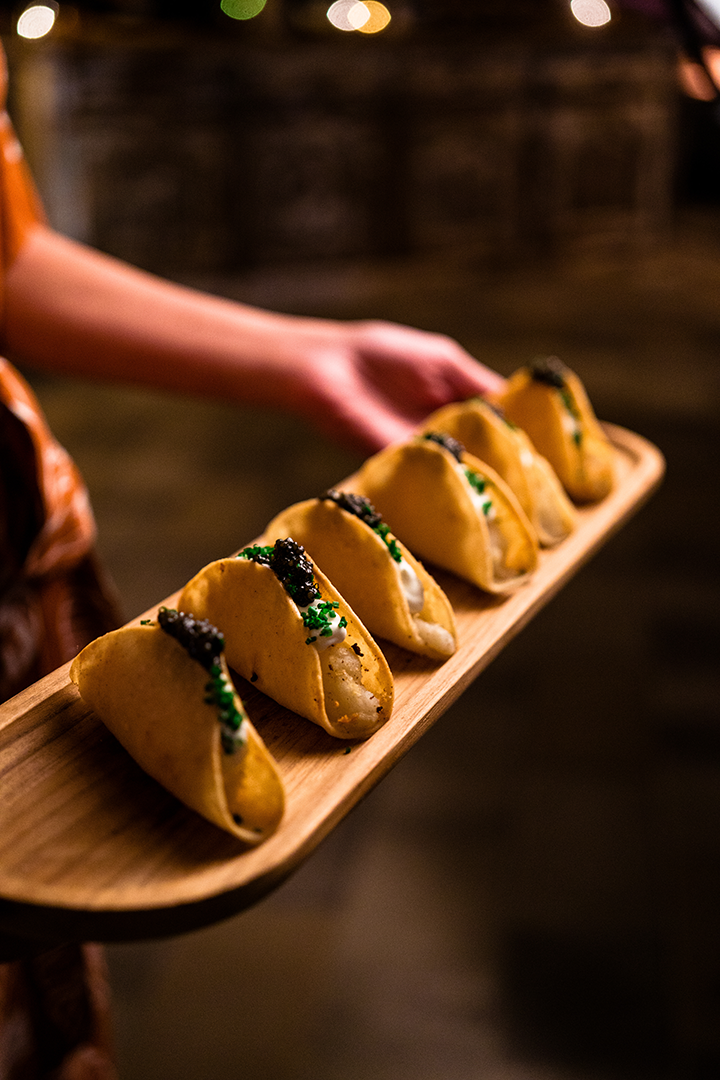If you ask different chefs to describe California cuisine, you will probably get different answers from each, but they’ll most likely all feature the same general idea.
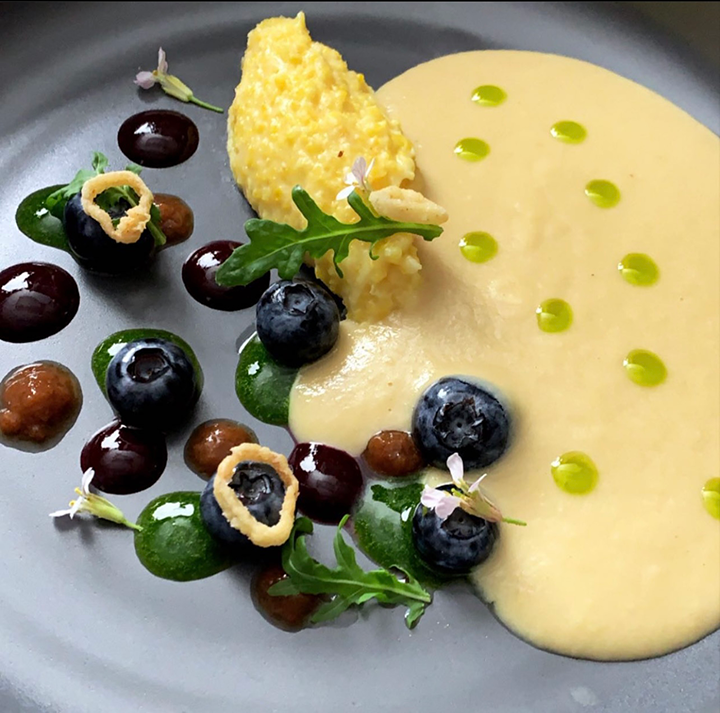
chive gel, blueberry gel, pink lemonade blueberry gel, corn soup, arugula leaves, and arugula flowers. Photo courtesy Keith Lord
Fresh. Sustainable. Organic. Seasonal. Local. Authentic.
Fusion. Simple.
“If you’re not using fresh, locally produced, amazing products, prepared simply and with nutrition and healthfulness in mind,” says Chef Keith Lord, owner of Strateje Fourteen (San Diego, CA), “what are you even doing?”
Not just farm-to-table
The term “California cuisine” can mean different things to different people. While some may use it as catch-all term for cuisine that hails from California, others may associate it more with the farm-to-table movement. But it is a little bit of both.
“Everyone uses and sometimes abuses that farm-to-table moniker, but it’s a movement that began with a small handful of American chefs, who changed what the French chefs in California were doing,” Lord says.
A History of California cuisine
- 1952: Helen Evans Brown publishes Helen Brown's West Coast Cookbook. She advocated using fruits and spices available in one's own neighborhood, forgoing poor grocery store substitutes, as well as fresh seafood, caught locally.
- 1971: Alice Waters opens Chez Panisse, whose menu incorporated the theory that it was of primary importance to use food that was fresh and in season, grown locally, organically, and sustainably. Because the ingredients were procured locally in California, the food took on a very Californian character, hence helping create California cuisine.
- 1973: Patrick Terrail opens Ma Maison, which is often credited with getting Wolfgang Puck's career off the ground and for starting the trend in cuisine known as "California nouvelle." Ma Maison was known for using ingredients sourced from the local farmers markets that highlighted the glory of California's produce and pairing it with French technique.
- 1978: Jeremiah Tower is hired at Chez Panisse.
- 1978: Sally Schmitt and her husband Don open the French Laundry, where they began serving single-menu monthly dinners that emphasized local ingredients.
- 1982: Wolfgang Puck opens his flagship restaurant, Spago. Spago is known for popularizing California-style pizza.
- 1984: Jeremiah Tower opens Stars, which is often considered one of the birthplaces of California cuisine.
- 1989: Mark Peel, who worked with both Alice Waters and Wolfgang Puck, opens Capanile, notable for its California cuisine.
- 1994: Thomas Keller purchases the French Laundry, which commits itself to creating classic French cuisine with the finest quality ingredients.
- 1999: Thomas Keller publishes The French Laundry Cookbook, which has been awarded three International Association of Culinary Professionals (IACP) awards for Cookbook of the Year, the Julia Child "First Cookbook" Award, and the Design Award.
- 2006: Daniel Patterson opens Coi, which emphasizes vegetables and foraged foods while maintaining the traditional emphasis on local foods and presentation.
The origin of California cuisine dates to 1952 when Helen Brown released her West Coast Cookbook, which advocated for the use of ingredients found in one’s own backyard rather than relying on what was available at the grocery store. California cuisine began to make a name for itself in the culinary world in the ‘70s and ‘80s when chefs like Alice Waters (Chez Panisse), Sally Schmitt/Thomas Keller (French Laundry), Patrick Terrail (Ma Maison), Jeremiah Tower (Stars), and even Wolfgang Puck (Spago) started embracing the bounty that could be found at nearby farms.
“The revolution that the menu started in 1976 has succeeded all too well. Everybody has all those ingredients now, and they’re all over the country,” according to Jeremiah Tower, in a 2017 interview with Eater San Francisco, about the development of the “New California Cuisine” dinner at Chez Panisse.
“I say too well,” Tower continued, “because everybody’s got all these ingredients now, and they want to put 15 of them on every plate, which is boring, silly, and not very good. It’s like a paintbox you get as a kid. There are eight colors. Then you get one that has 30 colors and you think it’ll be five times better, but you mix it up and you get brown. The world is full of brown plates.”
Characteristics of California cuisine
California cuisine is less about specific recipes and focuses more on dishes that are driven by fresh and sustainable ingredients, with special attention paid to seasonality and the bounty of the region.
“There are so many different regions in California that grow so many different products, that once you start to look around, you can find so many more amazing things are grown here than in a lot of other states,” Lord says.
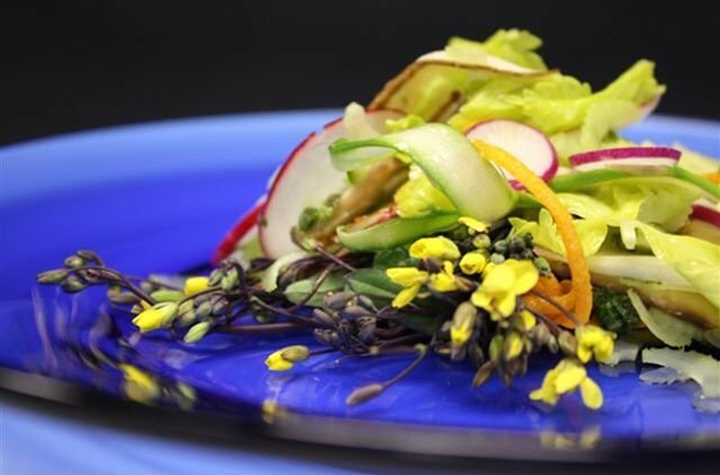
Shaved Portobello Mushroom Salad with asparagus, carrot, radish, celery leaf and heart, Belgian endive, asiago, and Meyer lemon. Photo courtesy Keith Lord
Dana Buchanan, owner of Primal Alchemy Catering (Long Beach, Calif.), agrees.
“California has been referred to as the Breadbasket of America. With over 400 different types of crops grown we are the fifth largest food producer in the world, so access is not an issue here and contributes to our ability to create with a wide variety of ingredients.”
In a nutshell, most chefs will describe California cuisine as: “A wonderful combination of seasonality, chef-forward cuisine, and creatively inspired menus,” says Rosemary Vera, owner of Colette’s Catering & Events (Fullerton, Calif). “We gather inspiration from the sunny weather, the abundance of produce available almost year-round, the coastline and all that it has to offer, and the fresh ingredients from local farmers and butchers. Seafood is a must, trendsetting flavors are always an element, and contemporary menu planning takes inspiration from all the different cultures that make our location truly unique.”
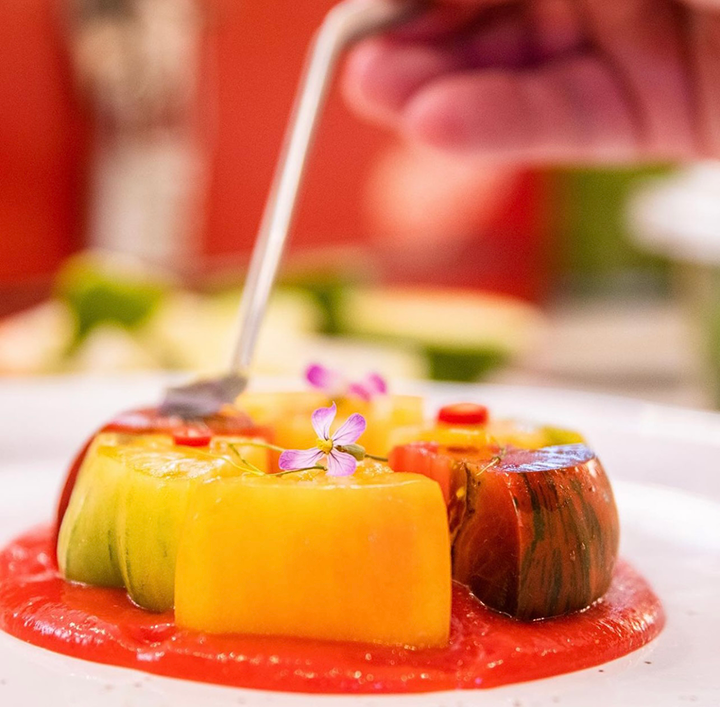
Tomatoes with togarashi, chive, red shiso, chilies, cucumber, and shiso puree. Photo courtesy lunaphoto
Let’s look more closely at the different facets of California cuisine.
Make it fresh.
Freshness is one of the most important aspects of California cuisine. Dishes that are low in saturated fats and high in fresh vegetables and fruits with lean meats and fresh seafood from the California coast often define the style.
“It is a fundamental fact that no cook, however creative and capable, can produce a dish of a quality any higher than that of its raw ingredients,” according to a famous quote from Alice Waters. “Always explore your garden and go to the market before you decide what to cook.”
Local and sustainable ingredients.
Not only do chefs want the freshest ingredients, but they also want to know where they have come from. It is easier to use microgreens that were picked that day from a local farmer rather than trying to import them from states away. Plus, working with local, sustainable vendors not only improves the ecosystem, but it also increases a sense of community, since the ingredients come from real people rather than a faceless corporate entity.
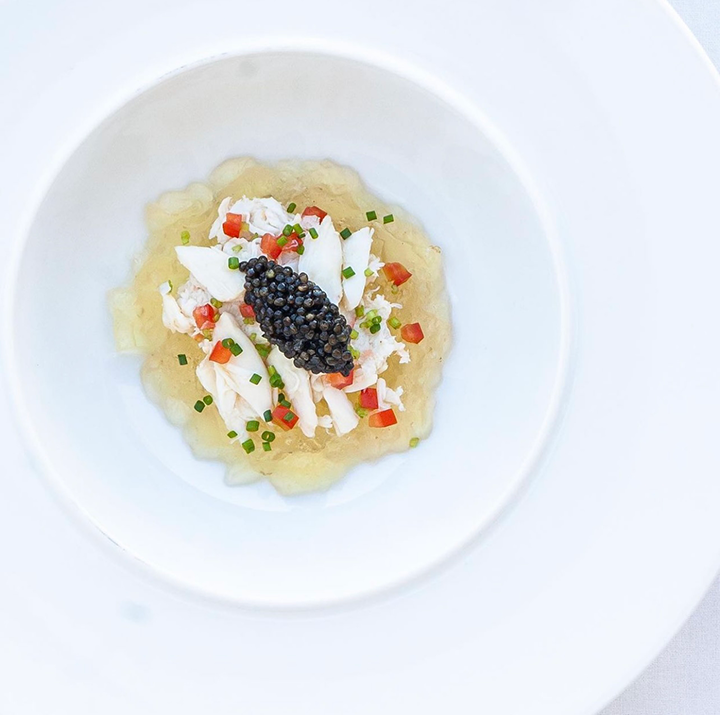
Dungeness crab with tomato eater star anise gelee, extra virgin olive oil, tomato, chive, crunchy salt, and caviar. Photo courtesy lunaphoto
“I think that just being seasonal and local is not enough, you need the sustainable component,” Buchanan says. “Making fresh ceviche with local seafood and ingredients and then serving it to guests in a plastic container, is not how I see California cuisine. I hope that more people care about where their food really comes from and that this isn’t just a fad but becomes the normal way of eating.”
Simple preparation.
Now, since chefs have taken the time to carefully source the best and most flavorful ingredients possible, it would be counterproductive to destroy their natural flavor by overcooking them or drowning them with other flavors. As such, California cuisine focuses on handling the ingredients as little as possible, and instead focuses on simple preparations that will allow their natural flavor to shine.
“When you have the best and tastiest ingredients, you can cook very simply and the food will be extraordinary because it tastes like what it is,” according to Waters.
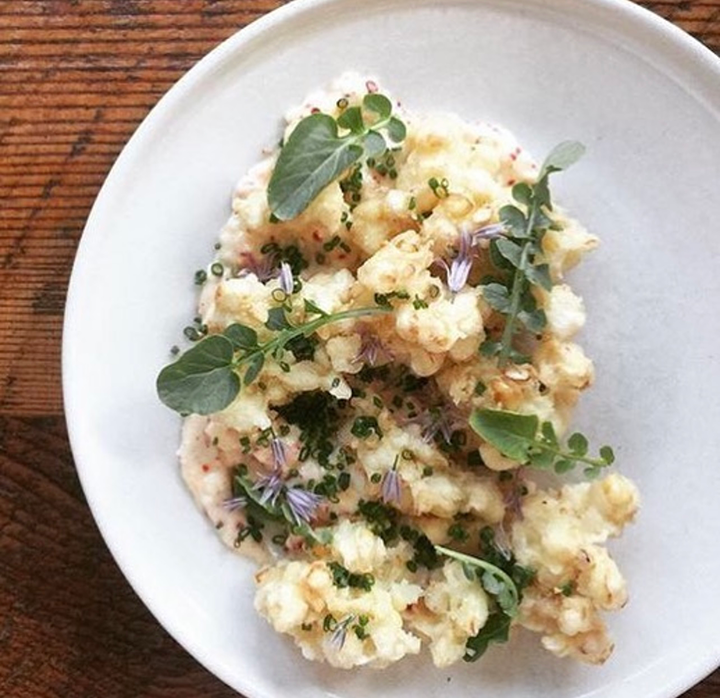
White corn Tempura with aioli, cotija, and lime. Photo courtesy Keith Lord
Lord agrees. “I am a purest at heart when it comes to cooking,” Lord says. “I believe that the carrots a farmer put his heart, soul, and all his resources into, should at the end of the day be prepared to taste as close to the warm in the ground perfect carrot the farmer grew. Simply cooked to reflect all that had already gone into that carrot.”
Global influences.
In addition to having an emphasis on lighter, seasonal ingredients, California cuisine also celebrates California’s melting pot of cultures through a myriad of international influences, including Mexican, Chinese, Japanese, Mediterranean, and Persian.
“Other than the obvious of local, seasonal, and sustainable; if you really break down California cuisine, you will find a lot of international influence,” Buchanan says. “Fusion is so woven into the style that it is hard to separate the components. It is not uncommon to find five to six ingredients representing different cultures in the same dish–and it works.”
Creative kitchens.
Another indicator of California cuisine is the kitchen itself. Many California chefs embrace the open kitchen concept, where guests can watch their food being prepared. Wood fired grills are also a California cuisine staple.
“We are fortunate we live in California and can be driven by local and sustainable ingredients in our way of cooking,” says Pauline Parry, Founder and CEO of Good Gracious! Events (Los Angeles). “Our food is driven by the distinct cultures we have here, which allows us to bring out the best in these clean flavors. We always want to taste the best in everything we cook and we really do have access to everything in California.”
Where new meets old
As more culinary styles embrace the farm-to-table movement, California cuisine can sometimes be lost in the mix. However, today’s California chefs are starting to look in their rearview mirror for inspiration.
For example, rather than focusing solely on the commonplace international cuisines within California, chefs are looking to their own family histories and cultural identities for culinary influences.
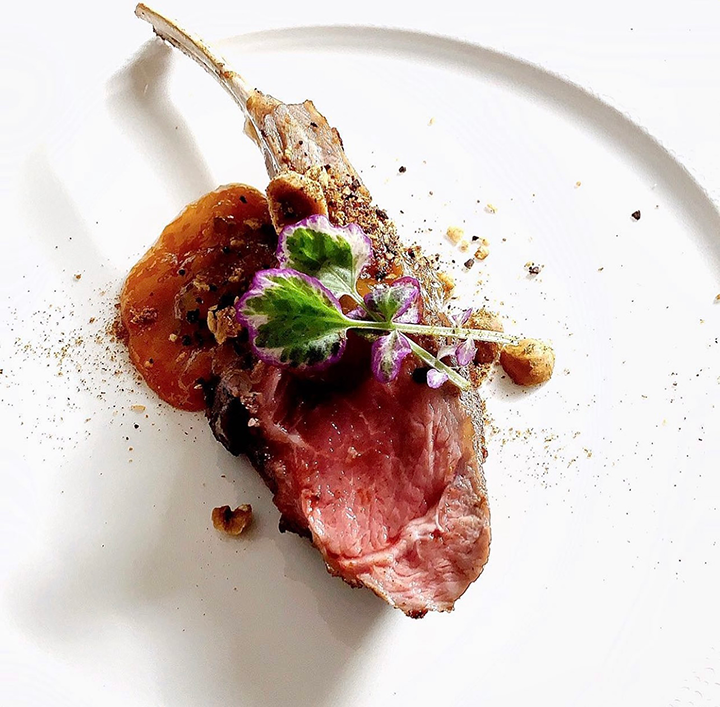
Lamb chop with mint glazed apricots, coffee ras el hanout dukkah spice, pistachio butter, and pink ice cress. Photo courtesy Keith Lord
Additionally, indigenous ingredients and practices are starting to come more to the forefront in California cuisine using local grains and probiotics. One restaurant in particular, Café Ohlone (located in Berkeley, CA), incorporates the Ohlone style of indigenous cooking, which honors the Ohlone traditions of gathering food responsibly, sourcing from farmers whose values reflect their own, and cooking what is in season—all hallmarks of California cuisine.
“We’re not really doing anything new, just remembering, supporting, and building upon what was the best of the past,” says Buchanan. “Farm-to-table should be more than a buzzword.”
Let’s eat
Since its inception, California cuisine has been instrumental in the rise of many of today’s most beloved dishes. For example:
California pizza developed by Alice Water and Wolfgang Puck
California pizza is a type of light thin-crust pizza with fresh local ingredients for toppings–artichoke, goat cheese, chicken, avocado. Instead of tomato sauce, sometimes peanut sauce can be used.
Cobb Salad, invented at the Hollywood Brown Derby
One night, the owner of the restaurant came home very hungry; he made himself a dish with whatever he had in the kitchen at that late hour: lettuce, egg, avocado, tomato, chicken, onion, bacon, and blue cheese. Thus, the birth of one of California’s signature dishes.
The California Roll, developed in Los Angeles
The California Roll is a fusion between Japanese and Californian cuisine and originates in Los Angeles in the 1960s. The roll is made with rice, cucumber, avocado, and fish, but is rolled inside-out. Practically, a Japanese dish made with American ingredients, in a new fusion style.
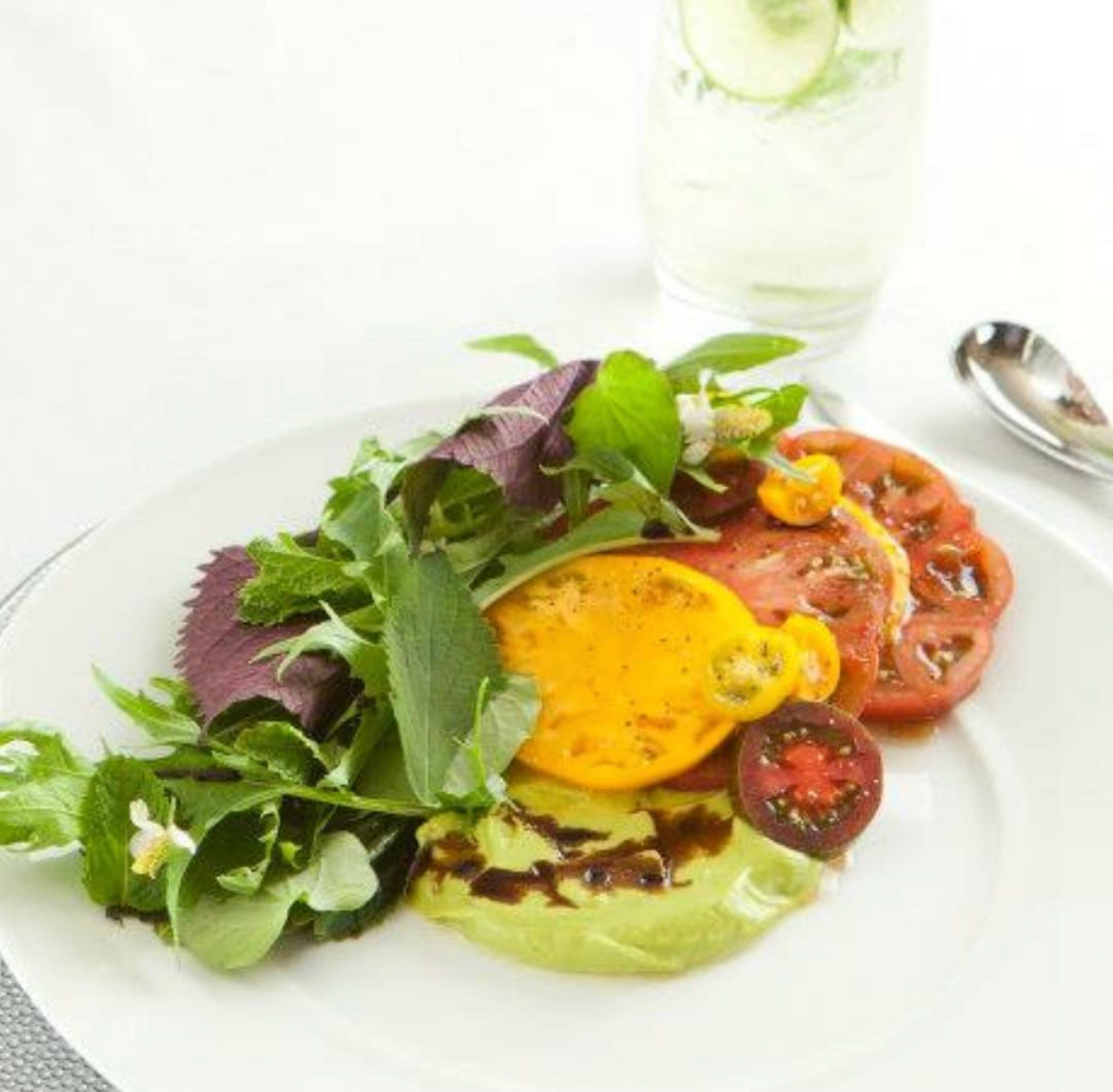
Warm Summer Farm Tomatoes (all the Vietnamese herbs, avocado purée with lemongrass, nuoc cham vinaigrette). Photo courtesy Keith Lord
While California cuisine, or more generally farm-to-table, will always be homebase for chefs, its lighter cooking styles and vegetable-centric menus, as well as its global mashups and greater emphasis on homegrown menus, continues to evolve.
In closing, here are some final words of wisdom from the mother of California cuisine, Alice Waters:
“Cooking creates a sense of well-being for yourself and the people you love and brings beauty and meaning to everyday life. And all it requires is the common sense to eat seasonally, to know where your food comes from, to support and buy from local farmers and producers who are good stewards of our natural resources,” she says.
Join us in California!
Don’t miss your chance to get a taste of true California cuisine during Catersource + The Special Event, happening May 2–5 in Anaheim, CA
- Colette’s Catering & Events will be catering this year’s Opening Night Party, which is being held at Muckenthaler Cultural Center.
- The Colony House, owned and operated by 24 Carrots Catering & Events, will host this year’s Leadership Lunch.
- Dana Buchanan will present Leading the Scene by Keeping it Green where she’ll discuss tips on producing sustainable events.
- Keith Lord will be presenting two Master Plating sessions: Scaling from 100 to 4,000 and On the Line Plating.
- Pauline Parry’s new book, My Culinary Love Story, will be available for purchase in the bookstore. She will also be presenting So, You Want to Write a Book?
Visit conference.catersource.com for all the details.
Caviar Potato Taco
Photo and recipe courtesy 24 Carrots Catering and Events
Ingredients
4-inch corn tortilla
Crushed, steamed russet potato, seasoned with salt
½ tsp Koji Crème Fraîche (recipe below)
2 tsp Tsar Nicoulai Reserve Caviar
Chive Chiffonade for garnish
Method
- Fill tortilla halfway with crushed potato and fold into taco shape.
- Pan-fry in a cast iron pan on both sides until golden and crispy.
- Slightly open taco and dollop 2 tsp of Koji Crème Fraîche, 2 tsp caviar, and finish with chives
Ingredients for Kogi Crème Fraîche
2 cups Crème Fraîche
½ cup salad oil
2 garlic cloves
4 T Koji
½ tsp salt
Method
- Puree until smooth.
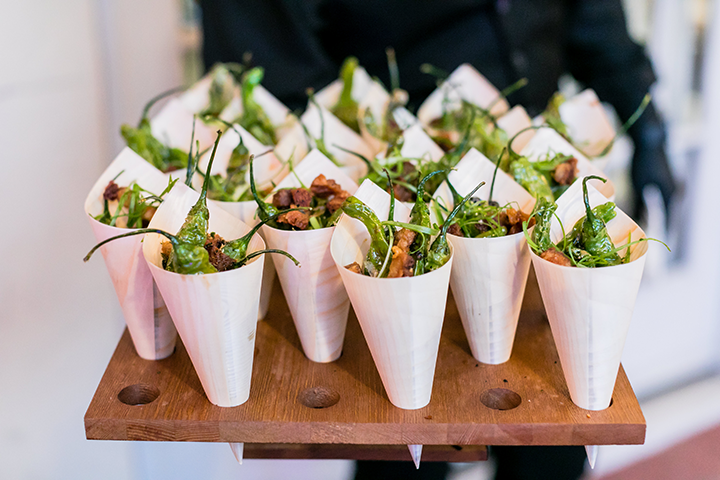
Pork Belly & Shishito
Photo and recipe courtesy Colette’s Catering & Events
Yield: 4
Ingredients for Confit Pork Belly
10 lb pork belly
4 cups onion, chopped
4 cups celery, chopped
3 ½ cups carrot, chopped
¼ cup rosemary
¼ cup thyme
4 lb pork fat
2 T coriander seeds
2 T star anise
2 T Szechuan pepper, chopped
6 T salt
4 T pepper
Method for Confit Pork Belly
- Score the pork belly on the fat with a diamond pattern
- Season with salt and pepper on both sides
- Sear pork belly on both sides until golden brown
- Remove pork belly and with the same searing drippings add vegetables and caramelize them
- Add all ingredients in a deep hotel pan with dry spices previously toasted
- Confit pork belly in pork fat for three hours at 275 degrees
- Remove pork belly from the confit liquid press over night with two sheet pans and some weight
- Dice pork belly into 1-inch cube size
Ingredients for Ponzu Glaze
4 oz garlic, minced
4 oz sesame oil
4 oz white sesame seeds
1 cup mirin
32 oz soy sauce
2 oz yuzu juice
2 oz lime juice
2 oz orange juice
2 oz rice vinegar
8 oz sugar
1 oz corn starch
1 oz water
Method for Ponzu Glaze
- In a small pot bring soy sauce to boil
- Add sugar and all other liquid ingredients
- Cook for 10 minutes at low heat
- Toast sesame seeds and ground half of the quantity and keep the other half whole and toasted
- At low heat toast minced garlic in the sesame oil until golden brown
- Combine sesame seeds and toasted garlic to the cooked liquid
- Prepare a slurry with corn starch and water add to your sauce and cook for additional 5 minutes at low heat
Ingredients for House Furikake
4 oz nori sheets
1 oz white sesame seeds
1 oz black sesame seed
2 oz toasted garlic, minced
1 oz sugar
1 oz togarashi pepper, chopped
2 oz rubu arare rice pearls
3 T bonito flakes
1 oz salt
2 oz sesame oil
Method for House Furikake
- Toast sesame seeds and garlic at low heat until golden brown, cool down after cooked
- Lightly toast the nori sheet and shred with a knife
- Combine all other ingredients and store in jar with silica gel packet
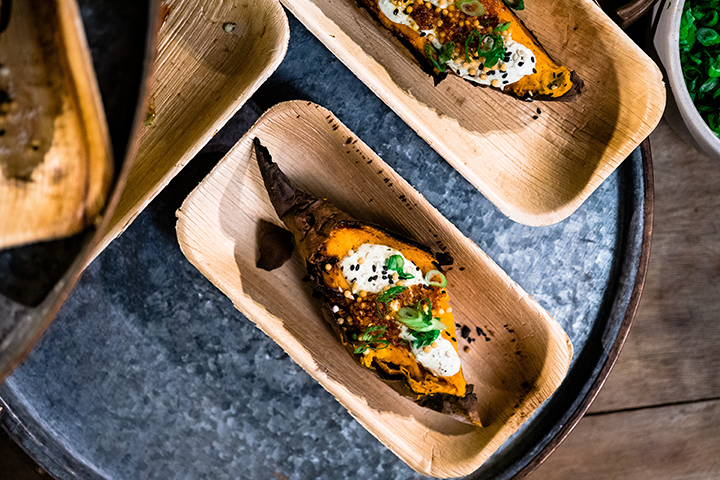
Charcoal-Roasted Sweet Potatoes
Photo and recipe courtesy 24 Carrots Catering and Events
Ingredients
Sweet potatoes
Japanese crunchy chili garlic
Toasted sesame seeds
Charred Scallion Crème Fraîche (recipe below)
Nori rice cracker
Fleur de Sel
Scallion chiffonade
Method
- Roast sweet potatoes on smoldering coals until cooked.
- Cut potatoes in half.
- Dress with all garnishes
Ingredients for Scallion Crème Fraîche
2 cups Crème Fraîche
12 scallions, charred and chopped
½ cup salad oil
2 garlic cloves
4 T Koji
½ tsp salt
Method
- Puree until smooth
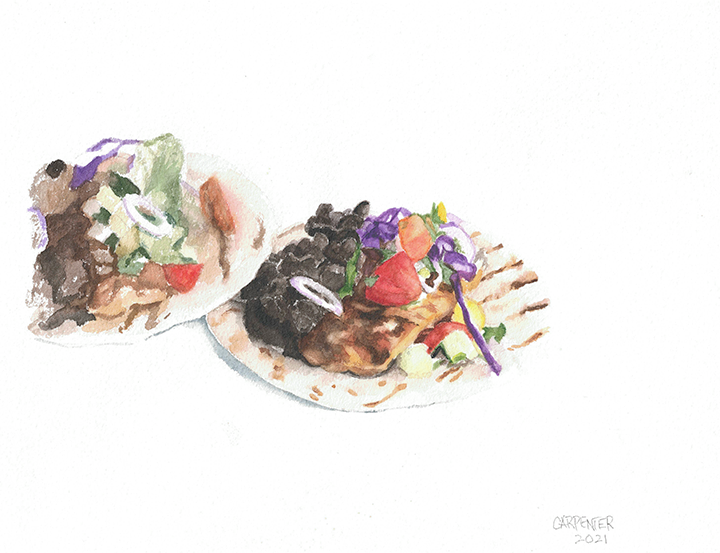
Illustration courtesy Janette Carpenter
Seafood Tacos
Recipe courtesy Pauline Parry, from My Culinary Love Story
Ingredients
3 T of extra virgin olive oil
Juice of one fresh lime
2 tsp of chili powder
1 tsp of paprika
½ tsp cayenne pepper
½ tsp ground cumin
1 ½ lbs cod or other flaky white fish
½ T vegetable oil
Kosher salt and freshly ground pepper
8 ea. corn tortillas
1 ea. avocado, diced
8 ea. lime wedges for serving
Sour cream for serving
Ingredients for Corn Slaw
¼ cup mayonnaise
Juice of 1 lime
2 T fresh chopped cilantro
1 tsp honey
2 cups shredded purple cabbage
1 cup corn kernels
1 ea. jalapeno, finely minced
Method
- In a medium shallow bowl, whisk together olive oil, lime juice, paprika, chili powder, cumin, and cayenne. Add cod, tossing until evenly coasted. Let marinate for 15 minutes. Meanwhile, make slaw. In a large bowl whisk together mayonnaise, lime juice, cilantro, and honey. Stir in cabbage, corn, and jalapeno. Season with salt and pepper.
- In a large nonstick skillet over medium heat, heat vegetable oil. Remove cod from marinade and season both sides of each filet with salt and pepper. Add fish flesh side down. Cook until opaque and cooked through, 3 to 4 minutes per side. Let it rest for 5 minutes and lightly flake with a fork.
- Serve fish over grilled corn tortilla with corn slaw and avocado. Squeeze lime juice over everything and finish with a dollop of sour cream.
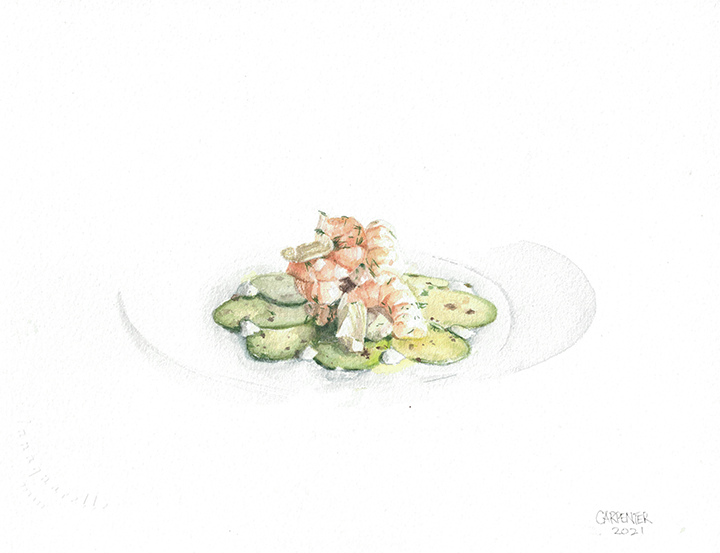
Illustrations courtesy Janette Carpenter
Shrimp Artichoke Avocado Salad
Recipe courtesy Pauline Parry, from My Culinary Love Story
Ingredients
6 ea. medium artichokes
Juice of one lemon
3 T extra virgin olive oil
1 T unsalted butter
1 T chopped parsley
3 large garlic cloves, chopped
Kosher salt and cracked black pepper to taste
2 4 ea. jumbo shrimp, peeled and deveined
¼ cup dry white wine
3 ea. large avocados
Method
- Trim artichokes to the base removing any tough outer leaves. Cut away the heart of the choke. Cut each choke head in 8 and place in bowl. Toss with the lemon juice and cover with water. Set aside for 15 minutes. Then drain the artichoke pieces.
- Heat half the oil in a heavy skillet over medium heat. Add the artichokes, parsley, and garlic, reduce heat to low and cook, stirring from time to time, about 15 minutes until the artichokes are lightly browned and tender when pierced with a sharp knife. Remove from skillet and cool.
- Add the remaining olive oil and butter to the skillet and add the shrimp. Season with salt and pepper then add the white wine and cook until the shrimp turns pink and lightly browned on outside.
- Peel avocado and remove the stone. To plate, thinly slice the avocado and place around the perimeter of the plate. Place the cooked artichokes in center and place cooled shrimp over the artichoke mixture. Swirl a little olive oil over the avocado and finish with salt and cracked black pepper to taste.
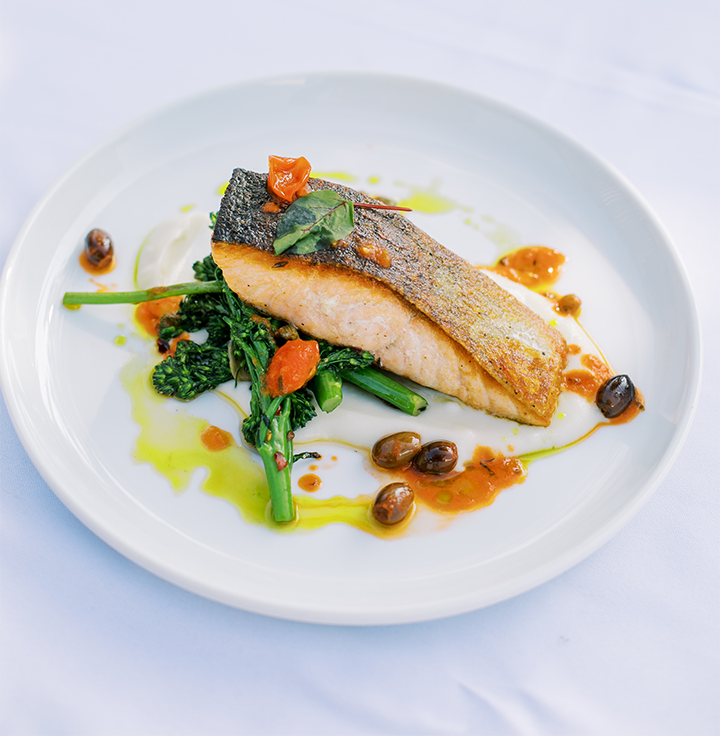
Crispy Salmon
Photo and recipe courtesy Colette’s Catering & Events
Yield: 20
Ingredients
20 ea salmon fillets, 7 oz
5 lb broccolini
4 oz garlic
4 oz extra virgin olive oil
2 oz chili flakes
2 oz salt
Sunchoke Purée (recipe below)
Puttanesca Sauce (recipe below)
Method for Broccolini
- Blanch broccolini for two minutes in boiling and salted water.
- Shock broccolini in iced water to maintain green color and crunchy texture
- In a pan cook the garlic with olive oil until golden brown and add chili flakes
- Add broccolini for an additional four minutes and season with salt
Ingredients for Sunchoke Purée
1 lb sunchoke, diced
4 oz shallot, minced
1 oz thyme
32 oz heavy cream
1½ oz salt
Method for Sunchoke Purée
- Peel and dice sunchoke
- Sauté the shallot with a drizzle of blended oil
- Add the thyme springs and diced sunchoke
- In a pot combine all ingredients and cook with heavy cream with very low heat
- Remove the sunchoke once tender, and transfer in blender
- Purée only the sunchoke and shallot with some of the cooking liquid and season with salt
Ingredients for Puttanesca Sauce
32 oz San Marzano tomato, sliced
Extra virgin olive oil
6 oz cherry tomato, diced
2 oz garlic, minced
2 oz capers
1 oz anchovy filet, minced
4 oz taggiasca olives
1 oz Italian parsley
Chili flakes
1 tsp salt
1 cup water
Method for Puttanesca Sauce
- Purée San Marzano tomato in a blender
- Sauté garlic with olive oil until golden brown
- Add chili flakes, parsley, cherry tomato, olives, capers, and anchovy filet and cook for 2 minutes
- Add San Marzano tomato and a cup of water and cook for 30 minutes at low heat
To Serve
- Sear salmon portion with skin side down until crispy
- Bake in the oven for 8 min at 375°F
- Serve with sunchoke puree, sautéed broccolini, and Puttanesca sauce
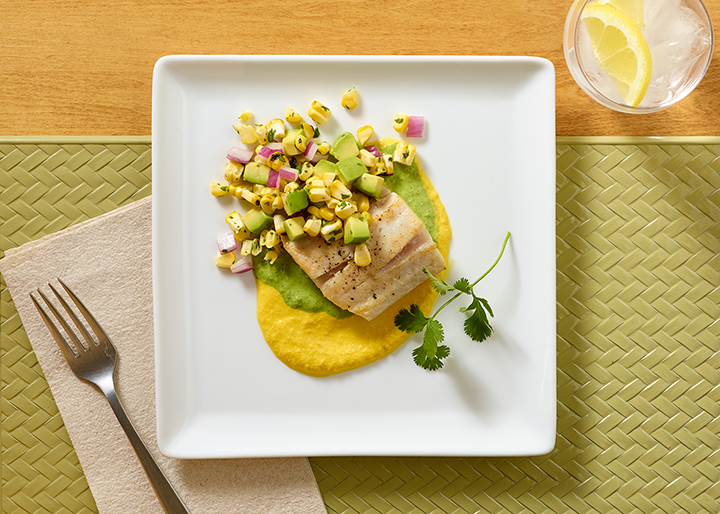
Corvina Sea Bass with Corn & California Avocado Salsa
Photo and recipe courtesy of UCLA’s Bruin Plate Restaurant
Ingredients
3 T extra virgin olive oil
1 ½ lbs corvina sea bass, cut into 2-ounce pieces
1 T salt
1 T ground black pepper
Aji Amarillo Sauce (recipe follows)
Cilantro Avocado Sauce (recipe follows)
Avocado & Corn Salsa (recipe follows)
Ingredients for Aji Amarillo Sauce
¾ cup chopped yellow onion
1 tsp chopped garlic
4 tsp grape seed oil
2 T, plus 1 tsp aji amarillo paste
5 T, plus 1 tsp queso fresco cheese
5 T, plus 1 tsp nonfat milk
Method
- Place all ingredients in a blender and puree until smooth.
Ingredients for Cilantro Avocado Sauce
4 cups cilantro
½ tsp aji amarillo paste
1 tsp queso fresco cheese
1 tsp chopped garlic
¾ tsp white vinegar
½ tsp lemon juice
5 T, plus 1 tsp plain yogurt
salt and pepper to taste
1 ea. fresh California Avocado, peeled, seeded
Method
- Place all ingredients except avocado into a blender. Puree until smooth. Add avocado and continue to puree until smooth. Transfer to a squeeze bottle.
Ingredients for Avocado & Corn Salsa
1 cup roasted corn kernels
¼ cup Fresh California Avocado, peeled, seeded, diced ¼”
2 T, plus 2 tsp red onion, diced ¼”
1 T, plus 1 tsp cilantro leaves, chopped
½ tsp minced garlic
2 tsp extra virgin olive oil
2 tsp lemon juice
Salt and black pepper to taste
Method
- Combine all ingredients in a bowl and lightly toss together until well incorporated.
To Assemble
- Preheat a flat top griddle to 350°F. Coat the griddle with the olive oil. Season each piece of fish with ¼ tsp. of salt and ¼ tsp. pepper. Arrange the 2 oz. pieces of corvina, skin side up, on the griddle. Cook for about 3 minutes or until golden brown. Turn fish pieces and cook for an additional minute or until internal temperature reaches 145°F. Remove from heat.
- Spoon 2 T of Aji Amarillo Sauce onto each plate.
- Squeeze a 2 T squiggle of Cilantro Avocado Sauce over the Aji Amarillo Sauce on each plate.
- Place 1 piece of corvina on top of the sauces on each plate.
- Garnish each with 2 T of the Avocado & Corn Salsa. Serve immediately.
f you ask different chefs to describe California cuisine, you will probably get different answers from each, but they’ll most likely all feature the same general idea.
Fresh. Sustainable. Organic. Seasonal. Local. Authentic.
Fusion. Simple.
“If you’re not using fresh, locally produced, amazing products, prepared simply and with nutrition and healthfulness in mind,” says Chef Keith Lord, owner of Strateje Fourteen (San Diego, CA), “what are you even doing?”
Not just farm-to-table
The term “California cuisine” can mean different things to different people. While some may use it as catch-all term for cuisine that hails from California, others may associate it more

